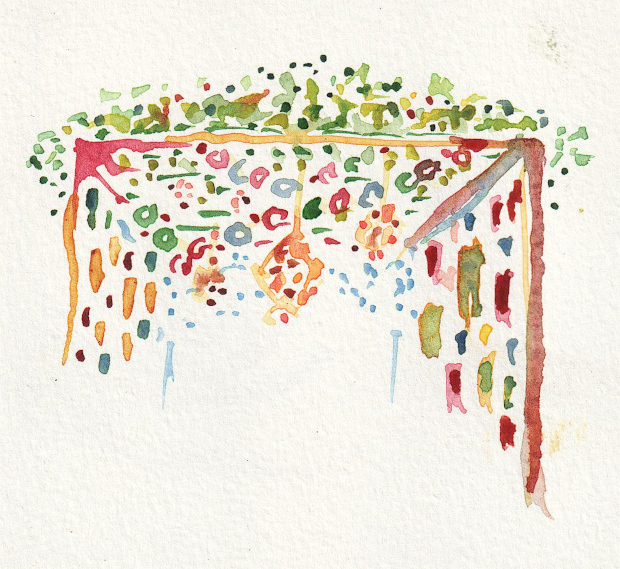
Every year I come up with new ideas on how to decorate a sukkah. This year for the first time I led a group of children, teens, and adults in creating sukkah decorations.
What is a Sukkah?
A sukkah is a temporary structure that Jews eat (and a few sleep) in during the fall holiday of Sukkot. It is topped with natural materials such as branches or bamboo. I enjoy decorating our sukkah. This gives the whole experience an extra hiddur mitzvah (beautification of a good deed).
What Kinds of Decorations?
Living in the Northeast of the U.S., the weather is unpredictable in the early fall. It often rains. So we have to waterproof our decorations as much as possible. To find ideas for decorations, I started looking up: “waterproof loop chains”. Having no success with that search, I soon learned that I should just look up “sukkah decorations”.
A sukkah has four walls. It also has schach, branches or slats of natural material that cover the top. In my mind, the decorations are divided into wall pictures and top hangings. If you have a solid wall on at least one side, that works for wall pictures.
When I was growing up, we had a canvas sukkah. It was hard to decorate the sides of canvas. So we hung decorations from the top. I have memories of sitting in the kitchen with my mother z”l, stringing cranberries.
In this post I will present different kinds of decorations.
Laminated Pictures

This is a laminated collage that I created with some cutouts and a printed Hebrew bruchim habaim (Welcome). I typed the letters in Hebrew using Gimp, a free software program. The cutouts are all from magazines or old flyers except for the ink sheep. I drew that one a few months ago. I colored in the letters with Derwent colored pencils.
When my children were little, they would bring home all kinds of laminated pictures. Many of these are still hung in our sukkah each year. The walls of our sukkah are covered with laminated pictures.
Pictures can have text, photos, glued cut outs from magazines or drawings. You can use crayons, markers, colored pencil or paint. I like adding new family photos to our sukkah each year. You can use hook and loop adhesives to attach your laminated picture. Hook and loop tape comes in rolls. One side is fuzzy. They easily attach and detach from each other. It makes it easy to re-use the pictures each year. I have bought hook and loop tape in the past on Amazon. This year I bought a few rolls of different sizes from the sewing company called Wawak.
One good idea for a sukkah picture is make a collage. First, take a photo. Then cut all kinds of magazine pieces, construction paper, and pretty papers. Place the photo in the center of a standard 8.5 x 11 printer paper. Create a design around the photo with cut outs. It can be color-themed, look like a sukkah, or just be whatever appeals to you. Once you are happy with the design, glue everything into place. Then run it through the laminator.
Last year I bought a laminator. You can find them on Amazon for not too much money. I used to struggle with clear contact paper to cover photos. A laminator is much easier. You also need to buy special plastic sleeves to enclose your photo or picture. This is a fun craft project for children or for seniors.
Loops and Chains
A traditional sukkah decoration is a long chain of loops. One could make paper loops in a sukkah. However, these are not waterproof. This year we made loops out of colorful plastic cable ties. You can buy colorful plastic ties on Amazon. You can see the loops in the pictures below of the etrog sun catcher and the plastic bottles apple.
Etrog Sun Catchers
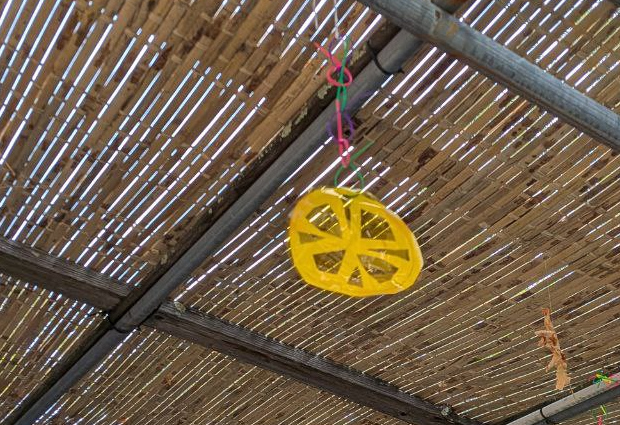
I found a blog post on creating these bright citron sun catchers. You need yellow cellophane (available on Amazon), yellow or orange construction paper, scissors, clear plastic tape, and string. The tricky part is the cutting of the paper. Other than that, I found children of varying ages were able to make these.
Someone in our group used red cellophane to create a big pomegranate. I am thinking next year I will buy purple cellophane so we can make grape sun catchers.
Apples Out of Bottle Bottoms

These apples from plastic bottles are a bit challenging to make. Children would need supervision and help to make them. First, you have to collect plastic water bottles with bumpy bottoms and with smoother bottoms. You create the apple by putting one plastic bottle top on the top and the bumpy one on the bottom. You add bits of red cellophane and/or red fabric to the inside. Green leaves go on top. I did the leaves with felt and sewed two leaves together. Then I glued them to the top of the apple. If you want to introduce hand sewing to someone, this is a good project to try. The hardest part is making two holes on the top of the apple in the plastic.
I am hoping to find even more projects to decorate the sukkah for next year.
Happy 5786! Hope you and your family have a happy, sweet new year.
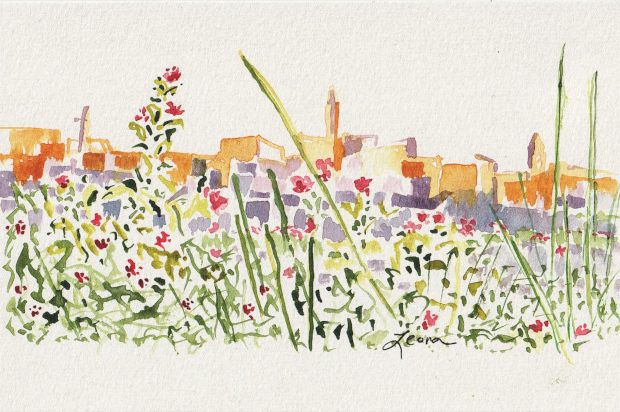
My last visit to Jerusalem was almost ten years ago. I photographed some red flowers billowing in front of the Old City of Jerusalem.
A few days I was looking for inspiration. I found a printout of the photo I had taken. I thought about shapes, colors, and composition. I wanted to capture the beautiful Jerusalem light and bring a little joyous color to my viewers.

I hope you enjoy these watercolors.
And to end off, here is a shofar. We approach the New Year of 5786. The shofar tells it is time to do teshuva (repentance). May we all be blessed with a year of happiness, health, prosperity, and good deeds.


I painted the bouquet of flowers (note the purple irises and the mask) that I bought from Roberts Florals in Highland Park, New Jersey on Purim. My guests enjoyed the bouquet along with the meal. I am relatively pleased with the result of the painting.
My current ultimate goal is to get better at painting portraits. I am confident in my flower painting abilities. I could improve in details, but I do not strive to be a realistic floral artist. One reason I chose to paint the bouquet is it was a good warm up to painting after Shabbat and after a week of little painting in general.
Why I failed miserably at 100 people week
Early in March there was a competition to draw or paint 100 people in a week. My start was delayed by Purim; I had lots of preparations to do for the holiday, and guests showed up to entertain us at our seudah (festive meal). Finally, I went out one day with my sketchpad and doodled quite a few people. I did not care much for the result, so it is not getting posted here. Then I ran out of time to go outside and look for people. So I went up to my attic late one night, and I took down several photos of people that I found inspirational.
How 100 people week Inspired Portraiture Adventures

One of the photos that I found was one of my sons showing a dandelion to a chicken. I did one quick sketch; the proportions of the head were off. I started another. I continued painting into the night, and I am please with the result: gouache media, lots of strokes and movement. I like how the light falls on the figures and the variety of hues established.
Here is another portrait that I did, from an old black and white photo of a relative eating soup. This portrait is also done with gouache. Maybe I will do another version in the future with more attention to the background.

More Flowers to Show
Whenever I go shopping with a certain friend, I am done long before she is. No problem! Each store seems to have a section of flowers. So I put my paid groceries in the car, and I return to draw with a Uniball pen whatever strikes me in the store. Often, the flowers stand out. Here are a few of my favorites:
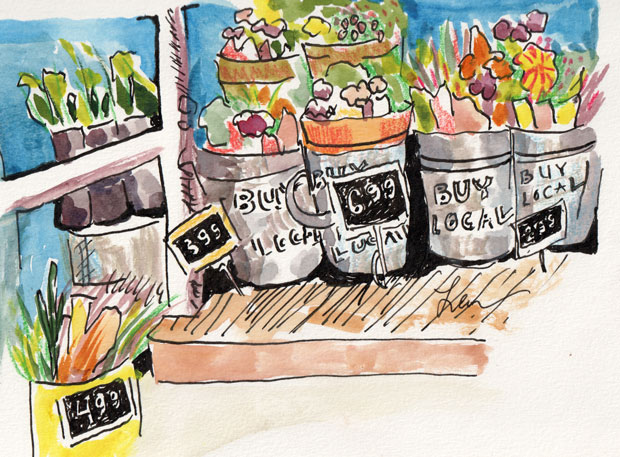
This one was painted after another one that had the brand name of a large chain store got rejected from an online shop that sells artists’ goods. Lesson learned: buy local flowers. Advertise local stores. No need to ruffle the feathers of any large chain stores.
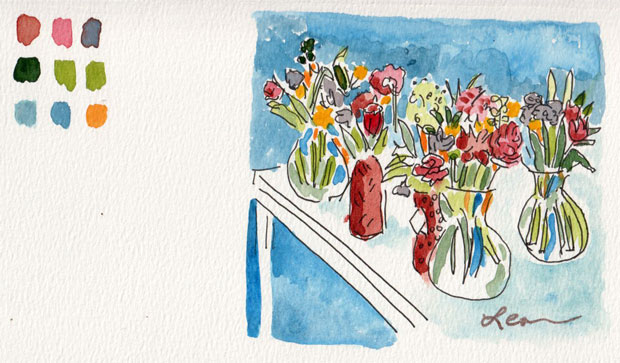
I often like painting a palette of colors near my watercolors. This palette compliments the flowers nicely, organic flowers shapes near geometric squares.
More on Painting Flowers
I am reading Painting Flowers in Watercolor with Charles Reid, a classic in the watercolor book world. Two ideas that I look forward to incorporating in future watercolor floral sketches or paintings:
1) Pay attention to negative shapes that the flowers make almost as much as to the flowers themselves. Do not overwork the details. Paint the background along with painting the flowers. The background should not be an after thought.
2) When painting the background, don’t do one solid expanse of one color. Do a variety of color in a mix that compliments whatever flowers one is painting.
Charles Reid uses a lot of cadmiums in his palette (Cadmium Yellow, Cadmium Orange). I will substitute colors in my palette, probably Hansa Yellow (light, medium, or dark) and New Gamboge. One exercise is to paint daffodils. Another is techniques for white flowers. Daffodils and magnolias are in bloom now. Hopefully, I will be able to experiment with his ideas.
It is now the Jewish month of Nissan. In Nissan we celebrate freedom on Passover. We are also commanded to say blessing on a fruit tree when it shows its first blossoms. I will be looking around my neighborhood for all kinds of blossoms for blessings and for sketches.


What is the motivation to choose a subject to paint? Why pick one object over another? Why would someone paint a particular person? I think the answer to all of these questions is emotional attachment. If you feel good or expect good feelings from painting a chosen object or person, you are more likely to enjoy the painting process and not feel like it is a task.
Why did I enjoy painting this wine bottle? I liked the looseness that I applied to the bottle. I also had fun with the patterned fabric underneath it.

A few weeks later, I painted these books on the same patterned fabric. It was in response to the theme of PATTERNS, an instagram challenge. I was able to pay careful attention to the details in part because I knew people on Instagram would be looking at the painting. I have emotional attachment to the fabric, as it was a purchase by my mother z”l.
The book of Illustrated Tehillim was given to me by my mother-in-law, as she knew I was looking for pictures of tehillim. Lamentations, the English name for the megillah of Eicha, is a book I am reading by Yael Ziegler, a wonderful speaker who I have met in person. Read it if you want a detailed, scholarly, and poetic approach to reading Eicha. I did this painting right after Tisha B’Av, the week we read parshat Nachamu, about comfort (Isaiah 40:1):
נַחֲמ֥וּ נַחֲמ֖וּ עַמִּ֑י יֹאמַ֖ר אֱלֹֽהֵיכֶֽם׃
Comfort, oh comfort My people,
Says your God.
Those books rest under Devarim, the parshiot we are reading now at this time of the summer.

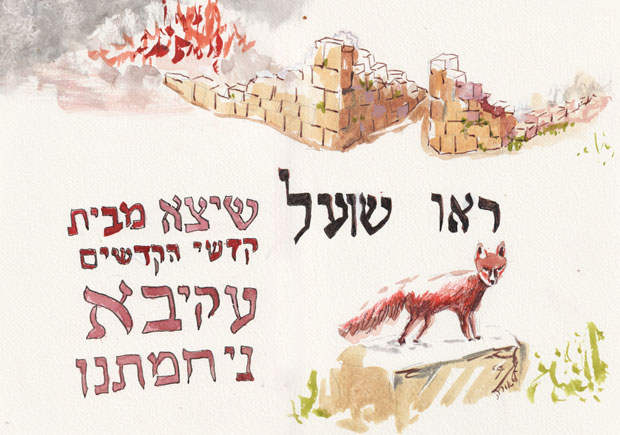
Tisha B’Av (9th of the month of Av) is the saddest day of the Jewish calendar. It occurs in the summer, sometimes in July, sometimes in August. This year it occurs on Sunday, August 7. I wanted to portray an upbeat story but still connect with the sadness. There is a famous story told at the end of the gemara of Makkot about Rabbi Akiva and a fox. The Beit HaMikdash (Holy Temple) was destroyed on Tisha B’Av. However, when it happened, Rabbi Akiva laughed. He laughed because he saw a fox coming out of the ruins.
When they arrived at the Temple Mount, they saw a fox that emerged from the site of the Holy of Holies. They began weeping, and Rabbi Akiva was lauging. Why are you laughing, Rabbi Akiva? … the prophecy of Uriah was fulfilled, it is evident the prophecy of Zechariah remains valid. Akiva, you have comforted us. Makkot 24B
I painted the Fox in Ruins once before, back in 2011. That one had a little Maccabee beer can, as I had been in the Old City of Jerusalem and was dismayed to see litter. I skipped the beer can in my 2022 version and emphasized the text of the Makkot gemara story.
My brand new Derwent Inktense watercolor pencils arrived just when I was finishing up this watercolor. So I added a bit of watercolor pencil to the underside of the fox.


Why is Purim theatrical? To learn about the hidden Purimspiel (Purim play), visit Bubby’s post “All the World is a Hidden Purimspiel“. Why do I start a post by linking to another post? Because this post on Sketching Out is really just an excuse to show you some of my latest artwork related to Purim.
This year we were fortunate to have two Adars, two Jewish months that contain Purim. This is to fix the lunar calendar by adding an extra month (sort of like February 29, but Adar II lasts for a whole month). It seems the joyous month of Adar is a great way to do that. The first Adar has a day known as Purim Kattan, small Purim. I did the painting at the top of this post in an attempt to do a tiny Purim, but it really does not look all that small.
The expression one says at the beginning of the month is: When Adar Enters, We Increase in Joy. Mishnichnas Adar Marbin B’Simcha.

I sent this to friends at the beginning of Adar (which had two new moons this year — two beginnings of Adar!).
Another expression for this time period is: V’Nahafoch Hu. May all the evil decrees be turned around! I used this to decorate the gifts of food that I give to my friends (Mishloach Manot or Shaloch Manos).

Two weeks ago a surprise parade came down my block. Our local shteibel was celebrating a new Torah (Hachnasat Sefer Torah). I did a drawing of a father and daughter dancing down North 8th. I later did a watercolor painting of the big float that passed in front of my house.
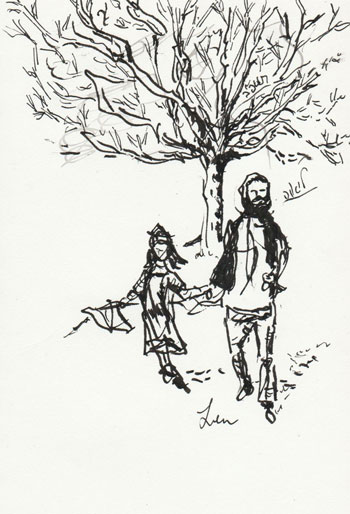
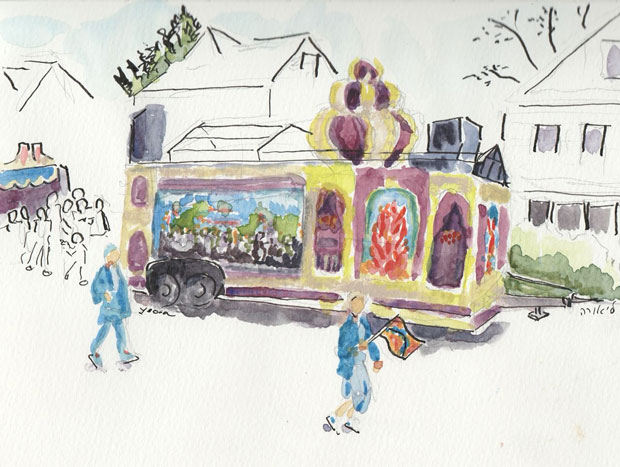
What I like about this painting is the use of color on the main subjects and leaving the rest simple and monochromatic. I am learning not to worry about all the details of each person.

Many of the piyutim (liturgical songs) that we sing at Congregation Etz Ahaim on Rosh Hashana and Yom Kippur are beautiful, memorable melodies, but one that stands out in particular is Et Sha’arei Ratzon (see the piyut on Sefaria). The poem was written by R. Yehuda ben Shmuel Ibn Abbas in the 12th century; it is a haunting retelling of the Akeida, the story in which Avraham brings his son Isaac as a sacrifice and then he is stopped by an angel. The repeated verse that most remember is “Oked veHanekad VeHamizbeach” – “the binder, the bound, and the altar.” Here is Avraham the binder bringing his son the bound on the altar – a scary, hard to explain, difficult to comprehend episode in the Torah. It seems like we too on Rosh Hashana are coming before God; like for Avraham, it is the “Et Sha’arei Ratzon” – the time of the gates of grace or desire. The Akeida is part of the Torah reading for Rosh Hashana.
My husband explained some of the midrashim of this song. The first is a lie that Avraham tells Sarah, that he is taking Yitzhak (Isaac), her beloved only son, to study Torah. In the next, Avraham, Yitzhak (Isaac) and his servants are approaching the mountain, but at some point the servants are told to stay behind because, according the English translation in the Sephardi siddur, they are not “spiritually worthy.” The Hebrew, however, calls them Hamor (may possibly be translated as donkey). When Isaac is taken to be sacrificed, he worries about his mother Sarah, how she will weep for him. The angels ask that Isaac be spared, that there shouldn’t be a world without a moon (i.e., without Isaac, who is compared to the moon).
The poet, who starts the poem with gates of “ratzon” (desire?) ends with gates of “rahamim” (pity, mercy) and a call for salvation.
Et Sha’arei Ratzon (Oked Vehanekad), sung at Congregation Etz Ahaim in Highland Park, New Jersey, on Rosh Hashana, is a poem written by R. Yehuda ben Shmuel Ibn Abbas in the 12th century; it is a retelling of the sacrifice of Isaac.




















